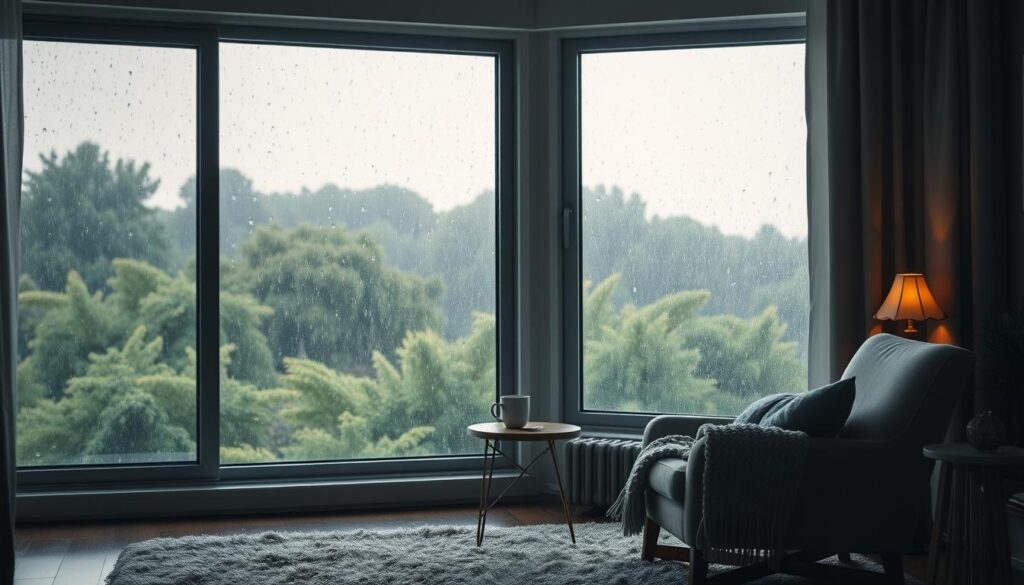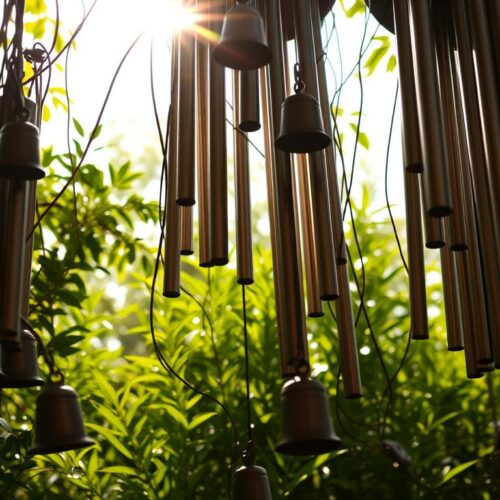Trying to improve baby sleep? The soft sound of rain might seem like a perfect fit. But can rain noise really help, or is it too overpowering for babies? This part looks at how rain compares to common sleep sounds, like white noise for babies. It also talks about using it safely in your home.
White noise mixes different sounds at the same level. It hides outside noises and helps babies sleep better. According to a 1990 study in Archives of Disease in Childhood, 80% of newborns slept within five minutes of hearing white noise. It’s a popular choice for quicker soothing and more consistent naps.
Rain noise is similar to pink noise, which is easier on the ears. It includes sounds like rain, wind, and flowing water. This makes it sound more natural than the buzz of machines. That’s why gadgets offer both sounds. Rain sound might be more soothing while still blocking out sudden noises at home.
When it comes to safety, always follow the experts. The American Academy of Pediatrics suggests keeping machines over seven feet from the crib. They also recommend staying under 50 decibels. A 2014 study by the AAP showed some baby sound machines were too loud. Always keep the volume low to safeguard hearing and support sleep.
Using these sounds has its ups and downs. The good points include hiding disruptive noises, setting a bedtime routine, and reducing stress at night. The downsides? There could be too much dependence on the sound, and the risk of playing it too loud. When using white or pink rain noise for babies, keep the sound low. Also, make sure your routine works even when you’re away from home. This helps keep the rain noise beneficial, not bothersome.
Understanding Rain Noise and Its Characteristics
Rain sound is like a gentle, even burst of energy. It’s mostly pink noise in natural showers. This means lower sounds are stronger than higher ones. This balance gives rain its full, rounded tone. It makes it less sharp than noises from speakers and more similar to wind and waves. This mix influences the comfort level rain noise brings to your space.
Comparing pink noise to white noise shows a big difference in sound. White noise has an even spread of energy across all sounds. It can seem bright or like static. On the other hand, pink noise, which rain is a part of, feels warmer and smoother. This quality makes it great for hiding outdoor sounds like traffic or people talking in the hall.
The steady rhythm of rain is perfect for helping babies sleep. It’s consistent without being too loud or sudden. Brands like Hatch and Marpac offer sound machines with rain settings. These settings, along with white, pink, and brown noise options, can be adjusted. You can change the sound, volume, and timer to fit the room and sleep times.
Think about pairing rain sound with other sleep aids. Dim lights, a cool room, and a solid bedtime routine make a big difference. The aim is to create a peaceful setting. This helps block outside noises while keeping the volume safe for kids.
- Spectrum feel: Rain with a pink noise quality offers a sense of warmth, which helps regulate its impact.
- Use case: This type of sound is better for blocking out voices and TV noise, not sudden loud sounds. It fits with the pink vs white noise comparison.
- Practical setup: For sleeping babies, start with a low volume, place the sound source away from the crib, and keep the noise consistent.
The Science Behind Rain Sounds
When you hear rain sounds, your brain begins to relax. This sound has a low, steady rhythm that helps you fall asleep quicker. For babies, this consistent sound helps calm their nervous systems after a day full of activity.
The brain uses steady rain noise to block out sudden loud noises. These can be things like car horns, barking dogs, or someone ringing the doorbell. This helps reduce startling, making it easier for us and babies to stay asleep.
Rain noise is a type of pink noise, which has a softer and more natural sound than white noise. It’s similar to sounds in the womb, helping babies feel calmer and soothe them.
Studies show that sounds from nature, like rain, can make us feel less stressed and lower our heart rate. This makes it easier to fall asleep. There was even a study in 1990 that showed white noise could help newborns fall asleep faster. Rain sounds work in a similar way but must be played safely for babies.
The American Academy of Pediatrics recommends keeping sound sources seven feet away and not louder than 50 dB. This ensures the sound is safe, doesn’t hurt hearing, and supports healthy growth. Too loud sounds can actually do more harm than good.
When picking a sound device from brands like Hatch or Yogasleep, make sure you can control the volume. And place it so it doesn’t exceed 50 dB. A carefully set-up sound environment can enhance the soothing effects of rain noises, promoting better sleep for babies and supporting their early hearing development.
The Calming Effects of Rain Noise
You notice how a steady shower softens the room. That’s the rain noise doing its magic. It’s like a sonic hug, calming us down and soothing fussy moments. With this consistent sound, babies settle faster and sleep more deeply.
Over time, the soothing sound of rain becomes a signal. Include it in your baby’s sleep routine after a feed and before turning off the lights. This routine tells the brain it’s time to relax, just like reading a bedtime story or gently rocking in a chair.
Studies show that nature sounds can make babies less stressed and more calm. A steady shower sound can block out loud noises like vacuums, barking dogs, or traffic. This helps babies get scared less often and sleep longer.
To make this work well, use it for both naps and nighttime sleep. Keep the speaker or sound machine far enough away, and make sure it’s not too loud. This advice comes from the American Academy of Pediatrics. It keeps your baby comfortable while making your nursery routine simple.
| Benefit | How It Helps | Practical Tip |
|---|---|---|
| Steady Rhythm | Creates a predictable backdrop that supports relaxation | Start playback 10–15 minutes before bedtime |
| Masking Household Noise | Reduces wake-ups from siblings, pets, and traffic | Use continuous audio rather than loops with gaps |
| Routine Cueing | Builds strong sleep links in a baby sleep routine | Pair with dim lights and a short story |
| Nature-Based Calm | Leverages nature sounds for babies to lower stress | Select a soothing rain sound without thunder |
| Safe Soundscape | Maintains comfort while limiting the rain noise impact | Keep device at a distance and moderate volume |
Disturbing Aspects of Rain Noise
Rain noise impacts kids differently. For some, it makes sleeping tough, especially if they’re in a light sleep. Rain sounds with thunder or loud parts can scare a child who is just about to sleep.
Playing sounds loudly is risky. The American Academy of Pediatrics warns to keep noise under 50 dB for safety. Sound machines from Hatch, Yogasleep, and LectroFan might go over this limit if they’re too loud or too close. It’s best to keep these devices far enough away to be safe but still block outside noise.
It’s important for the sound to stay the same. If it stops, your baby might wake up and miss the noise. This can make them rely too much on these sounds. It can make sleeping at daycare or when the power is out harder. Don’t put phones in the crib and turn off notifications so they don’t wake the baby.
The outside environment affects sleep too. Rain hitting the window can clash with inside sounds, making things worse, not better. You might need to adjust the sound level to keep things constant and calm.

- Keep volume near or below hearing safety 50 dB to protect developing ears.
- Place machines away from the crib to balance outdoor noise and reduce spikes.
- Avoid tracks with thunder or sharp transitions that can startle light sleepers.
- Use stable playback to prevent dependence on sleep sounds from growing.
Using Rain Noise to Help Babies Sleep
Start with soft rain sounds at a low volume—around 50 dB. Make sure the sound source is over 7 feet (200 cm) away from where your baby sleeps, following the AAP’s advice. This helps cut down the noise level but keeps the room nice and soothing for your baby.
Look for a white noise device or app that lets you adjust the volume, set timers, and play sounds all night. Products from companies like Hatch, LectroFan, and Yogasleep are good because they have settings for rain sounds. These sounds can become a helpful part of your baby’s sleep routine.
Apps are fine too if you put your phone on airplane mode, turn off alerts, and keep it far from the crib. Remember, devices should never go in the crib. Having the sound source in the same spot every night helps your baby sleep better.
If your baby tends to wake up between sleep cycles, keep the rain sounds going all night or throughout naptime. This way, the sound environment stays consistent. If you’re worried about your baby becoming too dependent on the noise, you can gradually lower the volume or use it for shorter periods.
Avoid bedtime sounds that change tunes or pitch. A consistent rain sound at night helps keep your baby calm, reduces the shock of sudden noises, and makes falling asleep easier. Always remember to follow the AAP guidelines and use a safe white noise machine.
- Set volume near 50 dB; keep device at least 7 feet away per the AAP 7 feet guideline.
- Pick a white noise machine or app with rain presets, timers, and continuous play.
- Use the same rain sound for sleep at naps and bedtime to cue baby sleep.
- Run all night for sensitive sleepers; fade volume over time to reduce dependence.
- Skip melodic tracks to prevent stimulation and limit rain noise impact.
Creating a Comfortable Sleeping Environment
To make a peaceful sleep space for your baby, use gentle rain sounds, a dark room, and keep it cool at 68–72°F. Lower the lights 30 minutes before sleep time. This keeps light levels even all night, helping to avoid waking up often.
Thoughtful use of rain sound is key. A soft, steady noise can hide household sounds and outside noise during naptime and early night. It’s especially helpful in homes with other kids, as it muffles sudden noises without waking the baby.
Start building a bedtime routine that your baby will know. Begin with a warm bath, change into cozy pajamas, read a short story, then play the soft sound. Do these steps in the same order each night to help your baby know it’s time to sleep.
Listen to the American Academy of Pediatrics for safe sleep tips: keep noise makers 7 feet away from the crib, don’t use the loudest setting, and read the instructions. For devices like Amazon Echo or Google Nest, use a timer and keep the sound low to avoid sharp volume changes.
It’s important to keep sleep cycles stable. Maintain constant sounds, temperature, and dim light to help your baby go back to sleep quickly if they wake up at night. If you have to check on them, use a tiny night-light to keep the room dark and calm.
| Element | Why It Helps | How to Apply | Safety and Tips |
|---|---|---|---|
| Sound | Gentle rain noise impact smooths sudden peaks and aids outdoor noise control. | Play continuous, even rain or white noise through the night. | Device 7+ feet from crib; low volume; avoid bursts or alarms. |
| Light | Darkness supports melatonin and reduces stimulation at wake-ups. | Use blackout shades; keep a small, warm night-light if needed. | Maintain one light level overnight to support self-soothing. |
| Temperature | Neutral warmth prevents overheating and chills. | Target 68–72°F with breathable sleepwear and a sleep sack. | Check chest or neck, not hands, to gauge comfort. |
| Routine | Predictable sleep routine cues tell the brain it’s time to rest. | Bath, pajamas, book, cuddle, then start sound before lights out. | Keep it short and repeatable, even for naps. |
| Timing | Consistent schedules align with natural rhythms. | Set regular nap and bedtime windows; watch sleepy signs. | Avoid overtiredness to reduce false starts and long wake-ups. |
| Household | Controls spikes from siblings, appliances, and traffic. | Close doors, soften latches, run steady sound near the hallway. | Coach quiet voices after bedtime; keep pets out of the nursery. |
By using steady sound, soft light, and clear bedtime signals, you make a sleep setting that’s calming and easy for your baby to recognize. Smart noise management and placing devices wisely help naps and nighttime be more restful.
Cultural Perspectives on Rain Sounds
In the U.S., families often use rain sounds at bedtime. They help replace harsh street sounds or apartment noise. This makes the rain sound less loud without taking away your focus.
City parents might use devices like a Hatch Rest or Google Nest to play these sounds. It helps cover up other noises like a dog barking or a delivery. Suburban families might go for sounds that mimic real rain more closely.
Different places have their own ways of using rain sounds. Some prefer rhythmic tunes, while others like simple loops. You might switch from white noise during the day to nature sounds at naptime. It depends on what works for your baby and where you live.
Thanks to services like Apple Music and Spotify, it’s easy to find what works. With smart speakers or phone apps, you can control the volume and set timers. This way, rain sounds can help everyone sleep better without changing your nighttime routine.
When family visits or a new baby comes, softer sounds can help keep the peace. In big cities, a steady rain sound can mask sirens and traffic. But in quieter places, a gentle track can help without making the room feel too isolated.
All over, caregivers like simple, repeatable sounds. They use well-known rain sounds to help everyone relax. These sounds keep things familiar and fit with the rhythm of your home and your child’s needs.
Guidelines for Parents Considering Rain Noise
Help your child sleep well by setting volume and location limits. Stick to the AAP’s advice of 50 decibels and keep noise-making devices 7 feet away from the crib. This keeps the rain noise gentle for your baby’s ears while still being effective.
Always use the lowest volume that still helps your baby sleep. It’s good to keep the same sound for naps and night-time sleep. Many parents let the rain sound play all the time. This makes the sound consistent, helping your baby sleep through sounds or when they wake up briefly.
Be sure to read your device’s manual and adhere to its safety tips. If using a smartphone, turn on airplane mode, mute notifications, and don’t place it in the crib. Use portable or battery-powered devices when away from home. They’re handy during travel and when there’s no power, and they help when outdoor noises get loud.
Not all babies like the sound of rain. You can try white, pink, or brown noise to see which one is best at blocking out home and neighborhood noises. It’s good to reevaluate the effectiveness of rain noise as the seasons change or when nearby sounds are different.
If you prefer your baby to sleep without noise eventually, start weaning off gradually. You can lower the volume bit by bit each week or use it for shorter periods. Continue to keep the sound at a safe 50 decibels and 7 feet away from the crib, as recommended by the AAP.

- Volume: Aim near AAP 50 decibels; pick the lowest level that works.
- Placement: Maintain at least a 7 feet distance from your baby’s sleep space.
- Consistency: Use the same settings for naps and nights for steady cues.
- Safety: Follow manuals; keep phones in airplane mode and out of the crib.
- Backup: Pack a battery unit for travel, outages, and outdoor noise management.
- Alternatives: Test white, pink, or brown noise if rain is not effective.
- Weaning: Reduce volume or duration slowly to prevent abrupt changes.
Frequently Asked Questions About Rain Noise
You might wonder if rain sounds are safe. The American Academy of Pediatrics suggests keeping speakers about 7 feet from the crib. They also advise setting the volume below 50 dB. This is good for hearing yet still calming. It’s a good idea to check the sound level by the crib so you can hear voices without yelling.
Could your baby get too used to it? Yes, it’s possible. To avoid this, you could lower the volume gradually each week. Or, you could reduce how long it plays once sleep gets better. Keep track of how your baby sleeps to make changes smoothly.
Should it be on all night? Some parents let it play continuously to maintain the same sleep environment. Others turn it off after their baby’s first deep sleep cycle. For light sleepers, any sound change might disturb them. So, be careful with adjustments.
Is rain sound better than white noise? It’s worth comparing white noise to pink noise. White noise is good at blocking out sudden, loud sounds like traffic. Rain noise falls under pink noise, which tends to be gentler. It’s better for soothing away constant, soft background noises.
Can an app be used? Absolutely. Just keep your phone out of the sleeping area, use airplane mode, turn off notifications, and watch the volume. Devices from companies like Hatch or Yogasleep are useful. But remember to keep them at a safe distance and volume level.
When is it time to stop? There’s no set rule. Some families choose to stop around age 2. Others might continue until their child is 3 or 4 years old. It depends on your child’s sleep patterns and comfort. Always reconsider your strategy after events like sickness or travel.
- Top baby sleep questions: Is it safe? Keep it at or below 50 dB, 7 feet away.
- Rain noise impact: Helps mask mild sounds; monitor for overuse.
- Rain sound safety: Use consistent settings; avoid placing speakers in the crib.
- White vs pink noise: White for sharp intrusions; pink-like rain for gentle masking.
Personal Experiences: Real Stories from Parents
Parents often share how a steady shower sound helps their baby sleep in loud places. The sound of rain helps babies settle quicker and wake up less. The key is keeping the noise consistent all night.
Lots of parents use devices like a Hatch Rest, Marpac Yogasleep Dohm, or Google Nest for rain sounds. They place the device far from the crib at a low volume, following experts’ advice. This method can lead to better and longer baby sleep.
Travel can change sleep routines. If babies rely on the sound, missing it might affect their naps. A portable device or a smartphone on Airplane Mode can help. Turning off alerts is important so they don’t disturb your baby.
Not every child likes the same sounds. While some prefer white, pink, or brown noise, others sleep better in silence. Testing different sounds helps find what works for your baby. Safety and observation are important during these tests.
Expert Opinions on Rain Noise Usage
Sleep experts from children’s hospitals find that steady rain sounds can soothe newborns. They help by covering up noises from the streets and inside the house. This type of sound works like soft pink noise, which is easier on babies than harsh noises, offering a calm background.
Clinicians giving advice on children’s sleep stress the importance of consistency. Using rain sounds at bedtime and keeping them on all night helps. It may lessen the chances of babies fully waking up. They also remind you to slowly stop using it once the baby’s sleep improves.
The AAP has guidelines based on studies. Some sound machines can be too loud. They suggest placing these devices about seven feet from the crib, aiming for about 50 dB. This ensures the rain sounds are safe but still comforting.
Why do white noise and rain sounds help? Neonatal teams say the womb is constantly loud. They suggest using softer noises like rain to block out sharp sounds. Picking sounds without loud surprises is especially good for babies who wake up easily.
Audiologists suggest choosing machines that are clear about their sound levels and limit volume. They advise to follow the instructions, watch for recalls, and test the sounds. Doing this follows AAP recommendations and keeps the baby’s environment safe.
When you want to stop using the noise, experts have tips. Gradually lower the volume and use the timer to shorten the duration gradually. Combining these strategies with a consistent bedtime routine and dim lighting can help. This approach is in line with pediatric sleep advice.
Clinicians also consider the normal noise in your house. If you live in a noisy area, rain sounds can help by blocking sudden noises. In a quieter home, you might only use rain sounds during specific times. This makes sure the use of rain noise remains thoughtful.
Interviews with pediatric sleep experts highlight a key advice: choose low-frequency, steady sounds. Setting the volume safely and placing the device correctly is crucial. This approach combines AAP guidelines, expert advice, and practical safety tips for using rain sounds in your baby’s room.
Conclusions on Rain Noise for Babies
Rain noise offers a steady, pink‑noise backdrop that helps babies fall asleep. It also hides outdoor sounds. Studies on white noise and nature sounds show they reduce stress and help babies settle faster. This comes from a study in 1990 that indicated babies sleep quicker with constant sound. The goal is to use rain noise wisely while focusing on safety, consistency, and how your baby reacts.
Let’s look at the benefits and drawbacks of rain sound. It can mask sounds like cars, pets, and people talking, helping with sleep. However, some babies might not like it or could become too used to it. If your baby starts needing it too much, reduce its use gradually. Include rain noise in a bedtime routine that also has dim lights, a cool room, and time to unwind.
The American Academy of Pediatrics has some advice. Keep sound devices over 7 feet away and the volume about 50 decibels. Don’t use the highest volume setting and make sure to read the manual. Pick sound machines or smart speakers with rain sounds, or use trusted apps. Just keep the phone out of the crib and turn off notifications. These steps help keep your baby’s hearing safe while blocking outside noises.
In conclusion, think about how rain noise affects your family. Try it for some nights, keep track, and see how it goes. If your baby sleeps better and longer, it might be good to keep using it. If not, it’s okay to try something else. Remember, using rain sounds is just one part of making wise sleep decisions for your baby. Aim for sleep that is safe, can be done every night, and suits your baby’s needs.




